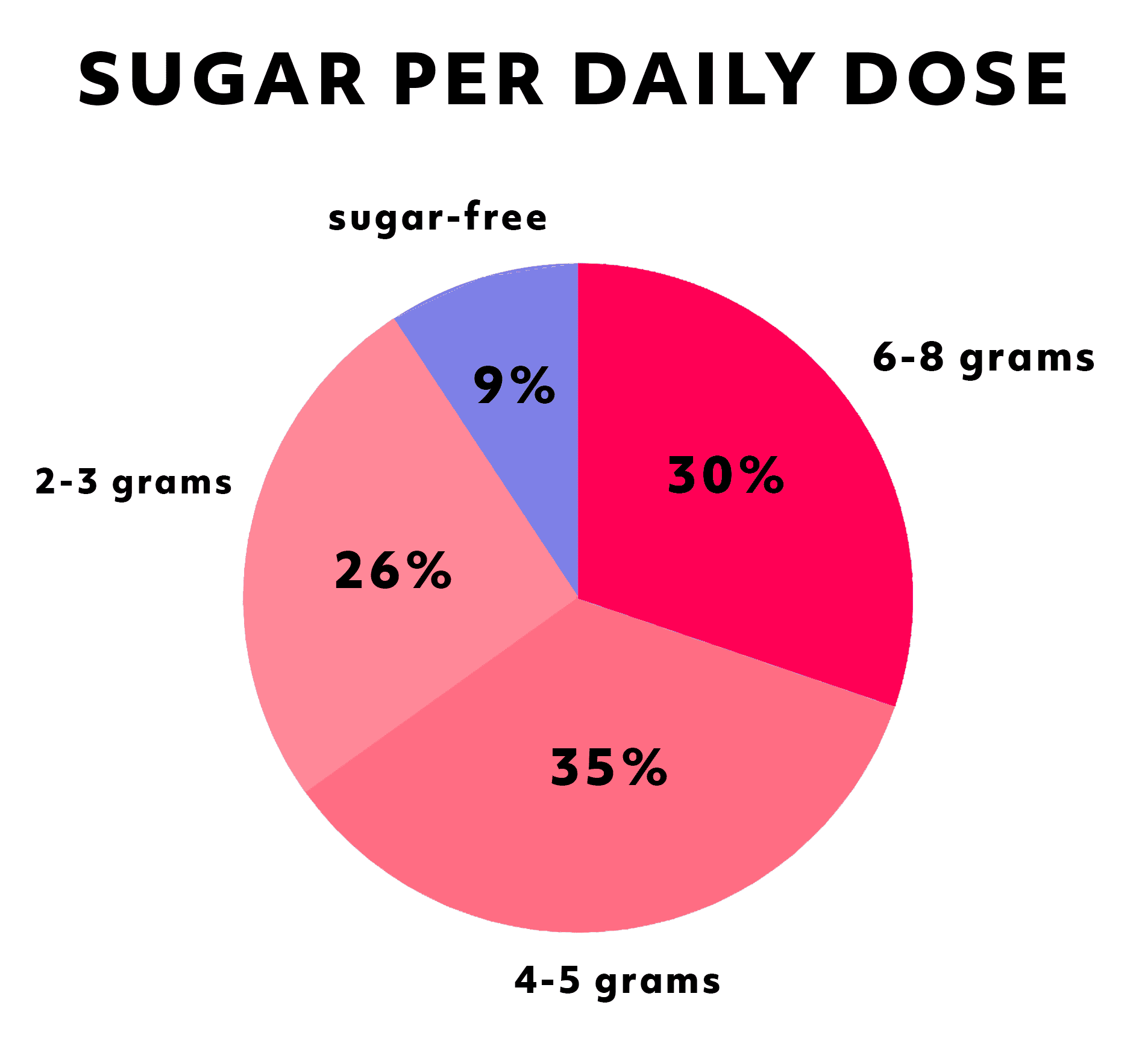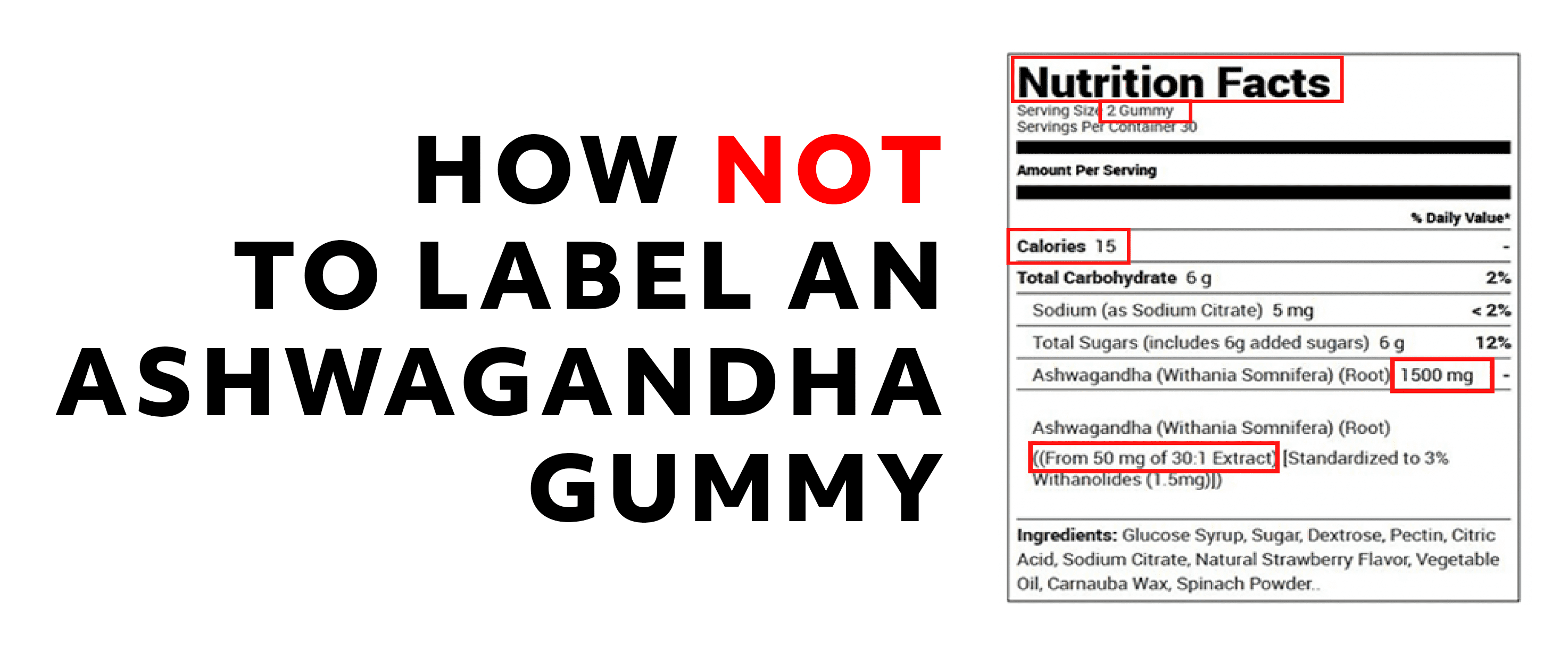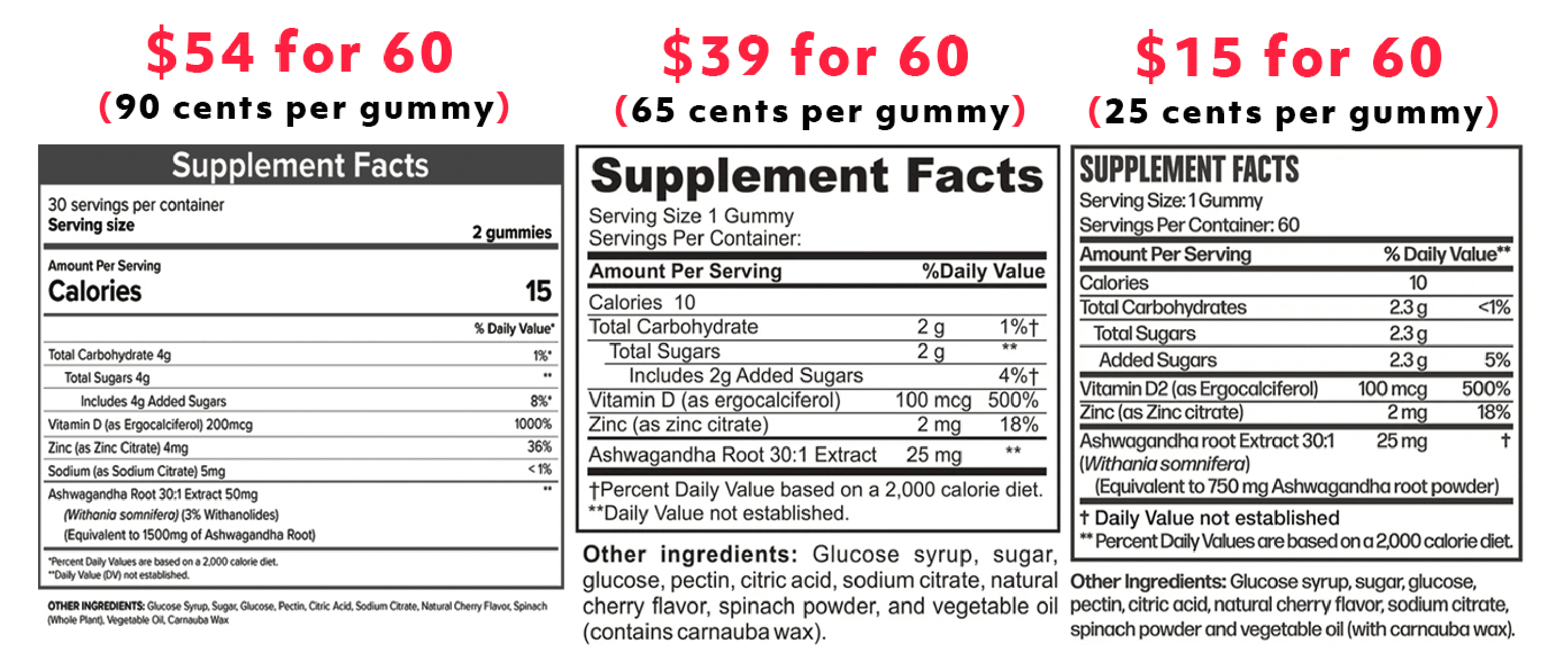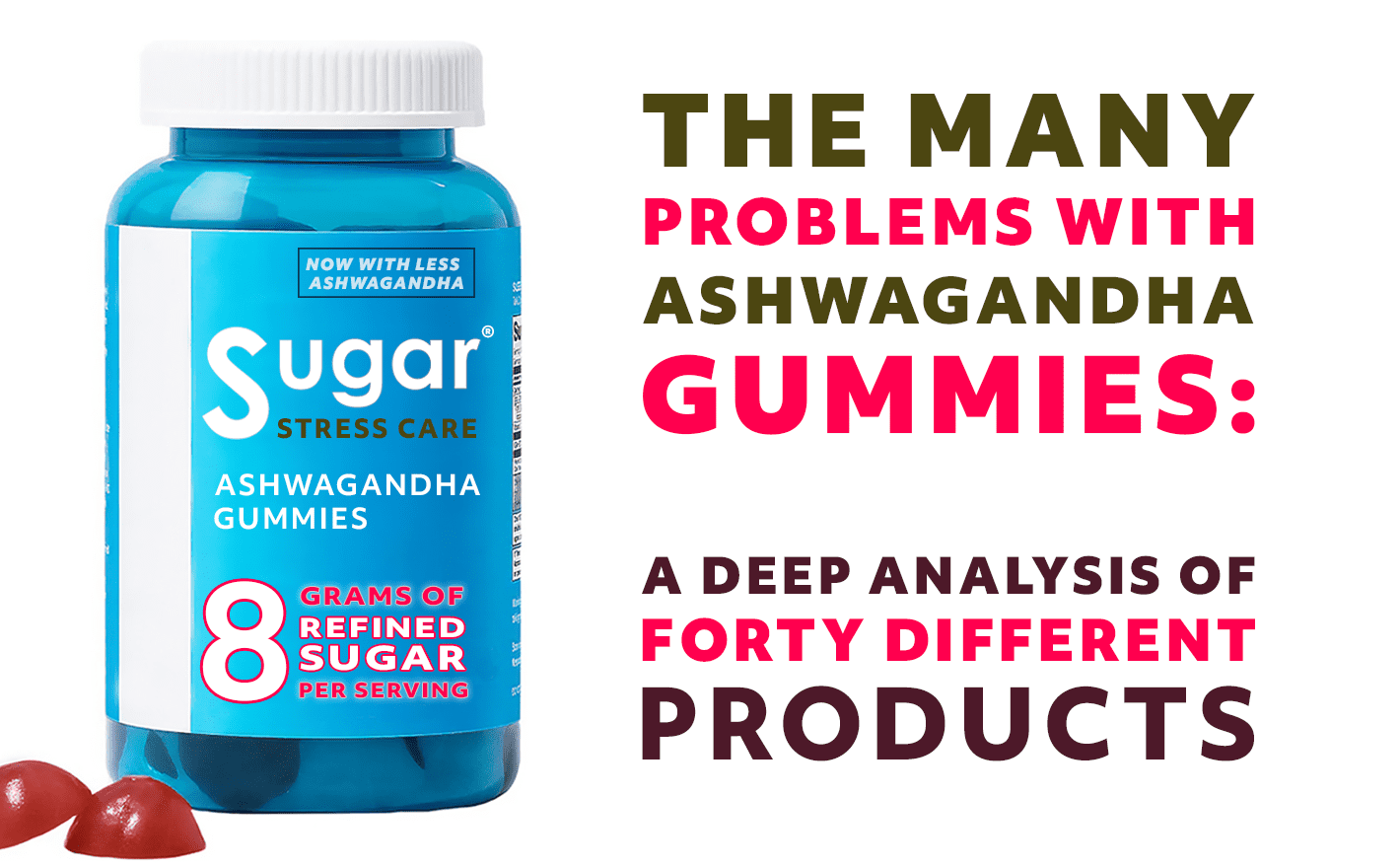To say that they’re popular is a gross understatement. All sorts of people are taking them these days. In fact, children’s gummies are only a small fraction of the products out there, as most of them are marketed for adults.
The idea of being able to take something delicious with a nice chewy texture is appealing, but there are a number of major trade-offs. For example, we found that about 30% of the Ashwagandha gummies that we reviewed contained between 6-8 grams of refined sugar per daily serving (many of which are likely GMO).
We also found that many of these products are beyond weak, to the point of likely having zero noticeable effects. Some of these super anemic, GMO-laden gummies will still run you over $50 for a month’s supply.
In order to figure out how potent an Ashwagandha product is, you need to look at the amount of withanolides (the active compounds that drive its effects). We found that the average amount of withanolides in the 40 products we reviewed was only about 10 mg per serving.
By comparison, a high-potency product such as CHOQ Ashwagandha will give you 105 milligrams of withanolides, over ten times that amount, in a single capsule (and with zero sugar).
The most potent ones we reviewed contained 30 mg of withanolides per serving, and the weakest only 0.5 mg. Thus, the overall variance in potency was massive, but the prices don’t always reflect the strength. Two products could be about the same price but one could be over 50 times as potent…and you’d never know unless you did your due diligence.
Ashwagandha gummy brands included in our review
Here’s the full list of every product we analyzed, in alphabetical order:
AFXMATE, Effective Nutrition, Emergen-C, Equate, Flamingo, Futurebiotics, Gaia, Goli, Himalaya, Horbaach, Hum, Joyli, Lilicare, Natrol, Nature Made, Nature’s Bounty, Nature’s Craft, Nature’s Key, Nature’s Nutrition, Nature’s Truth, Nature’s Way, NEVISS, Nourishvita, Nutricost, Nutririse, Obvi, PerpetuaLife, ProTKFU, Rite Aid, Safrel, SkinnyFit, Spring Valley, Trace Minerals Research, Tribe Organics, UCHEWS, Vitafusion, Vitamin Shoppe, Wild & Organic, Xwerks, and YouTheory.
As we go through our review, you’ll notice that we don’t call out any of the brands by name. That’s because we found some major problems with a good chunk of them and don’t want to point any fingers directly. By the time you’re done reading this article, however, you’ll have a good handle on what constitutes a good product.
As you’ll see shortly, about a third of these products had major issues with their labels. This was mostly due to the way that some of the lower quality products misrepresent the amount of Ashwagandha in each gummy.
Review of sugar content & sugar-free sweeteners in Ashwagandha gummies
After crunching the numbers, our review revealed that 36 out of 40 products (90%) used sugar. The average amount of sugar per serving in these products was 4.3 grams, with some as low as 2 grams but many containing between 6 and 8 grams of refined sugar.
Here’s a graph that breaks down the sugar content of all the ashwagandha gummies we reviewed:

Out of these 36 products, virtually all of them used refined sugar, with a couple using real food extracts or syrups. A handful of them specified that the source of the refined sugar was either non-GMO or organic, but the vast majority did not, which is a big problem.
Why? Because there’s a high probability that these products are using sugar from genetically modified sugar beets. According to the Non-GMO Project, over half of sugar made in the US comes from sugar beets, 98% of which are GMO. So, if you’re trying to avoid GMO sugar, make sure to read the label extra carefully.
Among the 4 products that were sugar-free, the sweeteners used included xylitol, malitol, and stevia.
Three of these sugar-free gummies had label issues, as they listed ingredients in a way that’s not FDA compliant, either misrepresenting the amount of Ashwagandha or labeling an ingredient in a way that covers up what it actually is.
There was only one product without sugar in our review that didn’t have label issues.
How many Ashwagandha gummies should I take?
On the one hand, this is a pretty easy question to answer: as many as are recommended on the label. The full answer, on the other hand, is a lot more complex.
As you’ll see in a moment, the potency of these products varies massively. For example, in order to actually feel a difference in your energy and stress levels, you could take just 2-4 of some of the best gummies per day.
A large number of these products were significantly underdosed, however, and so–based on the numbers–you’d have to take anywhere from 8 to 12 of them to get any results at all for mood, cortisol, or whatever else you’re looking to address.
Review of Ashwagandha gummy strength based on amounts of active compounds
While the strongest tiers of Ashwagandha gummies still have over 70% less withanolides than the highest potency pills or capsules, they do contain amounts that are shown to be effective in research.
As we mentioned previously, the average withanolide content of all of the gummies we reviewed was about 10 mg, but they ranged anywhere from 0.5 to 30 mg per serving. We had to exclude 2 of them because they were so severely mislabeled, so we included 38 total in this graph.
Here’s the breakdown:

(Note that some products use clinically verified proprietary Ashwagandha extracts (KSM-66® or Sensoril®), and do not always list the percentage of withanolides on the label. These percentages are published, however, so we used those numbers.)
While it’s encouraging that there were a fair amount that have quantities in the clinically effective range, it’s troubling that about 1/3 of them have 2 milligrams or less.
It’s hard to decode these labels, so do your best to read them carefully. To make matters worse, a lot of gummies aren’t even labeling the amounts of Ashwagandha properly…
Major issues with inaccurate labeling of Ashwagandha gummies
About a third of the products we analyzed had major issues with their labeling. In a few cases, ingredients used included vague terms like “natural pigment” and “fruity extraction”. These are not considered proper ingredient terms, and so they’re suspect.
The biggest problem we found was labels that misrepresented the amount of Ashwagandha in each gummy. In the herbal extract world, it’s common to list an herbal extract as being ’30:1′, suggesting that the extract is 30x the potency of the original raw herbal material.
What ’30:1 extract’ really means is that they started with 30 grams of raw Ashwagandha and then finished with 1 gram of extract. It absolutely DOES NOT MEAN that it has 30x as many withanolides, however. This is a critical distinction.
There’s a right and a wrong way to label these kinds of extracts. You have to first list the actual amount of the Ashwandha extract in the quantity section of the panel, and then you can say what the equivalent is below.
Many brands are reversing this to make it seem like there’s more in there than there actually is, which is abhorrent. Never buy a product from a company that does this.
Here’s the worst label we found out of all 40:

Talk about amateur hour.
There are just so many things wrong with this label. In addition to switching the actual quantity of Ashwagandha extract and raw herb equivalent, this label also:
- Miscalculated the number of calories (6 grams of sugar = 24 calories as sugar is 4 calories per gram)
- Forgot to pluralize ‘gummy’
- Used the phrase ‘Nutrition Facts’ instead of ‘Supplement Facts’, which is the proper term for all supplements
Be careful out there in the Wild West of Amazon! That’s where a lot of these super shady products love to hang out (especially CBD and Keto gummy scams like the fake Shark Tank ensorsements, which we go into in this article).
Lastly, after looking at 40 different labels, one more pattern emerged: carbon copy products.
Carbon copy Ashwagandha gummies: identical products with VERY different prices
This is something that you’d only know after looking at a huge amount of different products, so most folks won’t ever know about this unless they read an article like this.
Our review found that 25% of these products (10/40) were carbon copies of other products with virtually identical supplement facts panels. That’s more common among smaller companies that use plug-and-play recipes from contract manufacturers instead of custom formulating their own products. Unfortunately, this is pretty common in our industry.
Unsuprisingly, these 10 products represented some of the lowest potency gummies with the most amateurish labels.
Here are 3 different supplement facts panels from products that are very likely made in the same facility, but with prices that vary by almost 400%:

Notice also that these all contain ‘vegetable oil’, which often means some kind of highly processed seed oil they don’t want to disclose…not to mention that they only have 25 mg of Ashwagandha extract per gummy!
At 3% withanolides, that amounts to 1.5 mg of active compounds per day, which is 95% less than the strongest gummies we reviewed. Imagine paying $54 for a one-month supply of a product that has 1/20th the potency of another gummy that’s half the price. It happens all the time.
Ashwagandha gummies vs pills: more sugar, more chemicals, less Ashwagandha
Everyone loves gummies. After all, they’re delicious and they remind us of our childhood. But, at the end of the day, you’re usually getting a weaker product with a bunch of extra refined sugar, preservatives, and so-called ‘natural flavors’.
These flavor chemicals are anything but natural and were found in over 90% of the products in our review. By law, natural flavors can contain toxic petroleum-based preservatives. They’re way more synthetic than you think, and some of them even turn into known carcinogens like benzene.
If you compare even the most potent of the gummies in our analysis, you still find that it has less than 1/3 as many active compounds per daily serving as CHOQ Ashwagandha. So you could:
- Take 2-4 gummies per day and get anywhere from 0.5 – 30 mg of withanolides, up to 8 grams of sugar, plus natural flavors and preservatives OR
- Take just 1 capsule per day of CHOQ and get 105 mg of withanolides with no sugar, no flavor chemicals, and no preservatives
If you’re still dead set on buying Ashwagandha gummies though, we hope that you use the information in this article to make a more informed choice, and remember to always read the fine print!
If you’d like to learn more about adaptogens & supplement transparency, check out these blogs:
- Why proprietary blends suck
- How long does Ashwagandha take to work?
- Scam Alert: Shark Tank weight loss & CBD gummies
- Why Andrew Huberman is dead wrong about Indonesian Tongkat Ali




